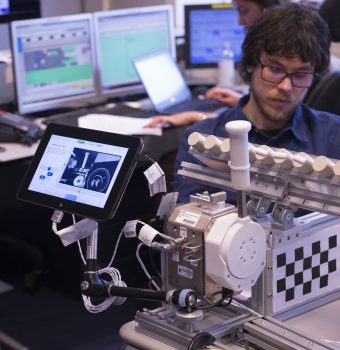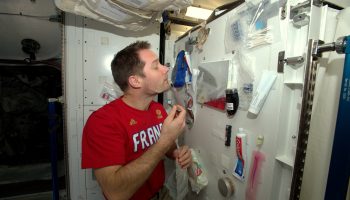Today, the International Space Station became a testbed for technologies that will allow astronauts to control rovers on planets as they orbit above. The Haptics-2 experiment allows astronauts to feel the force through a connected joystick that transmits feedback across great distances.
In Europe’s Columbus laboratory, ESA astronaut Thomas Pesquet set up a joystick that was linked to its twin at ESA’s technical heart in the Netherlands. Each joystick moves the other and accurately conveys force, allowing their operators to ‘shake hands’ and feel each other’s push and pull.
Thomas and ESA’s Thomas Krüger proved the system was ready by moving the joysticks and the astronaut commented “a firm handshake!” Thomas then spent over an hour ‘feeling’ different materials in the Netherlands through the joystick. He rated them on a scale of 1–10 to gather data on how astronauts can distinguish object stiffness remotely. This is important for more advanced remote robotic tasks in the future.
Spooky to see joystick seemingly move on its own @ESA_Tech controlled by @Thom_astro in space. #Proxima #Haptics2 pic.twitter.com/eXCmAq4ub1
— Human Spaceflight (@esaspaceflight) January 31, 2017
Controlling a rover on Mars is a real headache for mission controllers because commands take an average of 14 minutes to reach the Red Planet. Space exploration will most likely involve sending robotic explorers to ‘test the waters’ on uncharted planets before sending humans to land – and ESA is preparing for that future.
This Haptics-2 experiment falls under the Meteron project that is developing the tools to control robots on distant planets while astronauts orbit above. This includes developing a robust space-internet, designing the software to control the robots and developing the interface hardware.






Discussion: 2 comments
Thomas, je pense que ce doit être extraordinaire de se dire que les expériences menées pendant ces 6 mois serviront à améliorer les missions spatiales pendant des années et des années … mais que de progrès déjà depuis le début de la conquête spatiale!
Merci beaucoup pour le partage de toutes ces expériences. J’ai également acheté le livre pour la liberté de la presse et je me régale de vos explications et photos. Je suis une grande fan de la conquête spatiale. Merci d’avoir “vulgarisé” des termes afin qu’ils soient à porté de tous. Merci, Thomas.